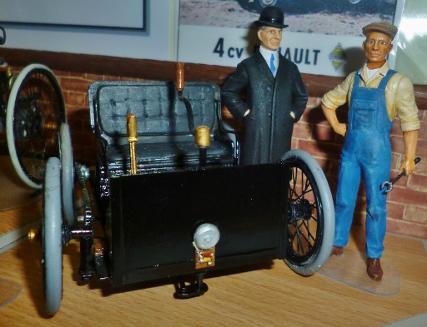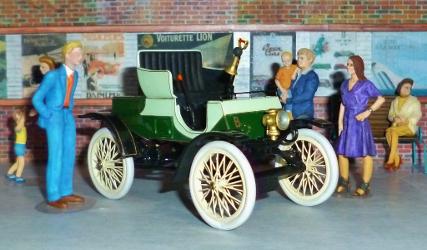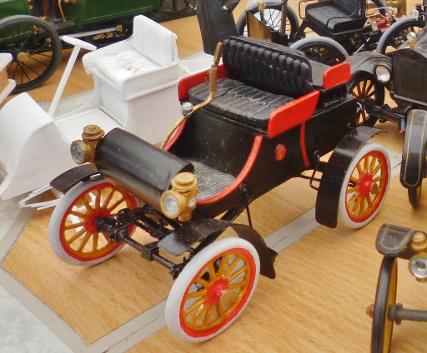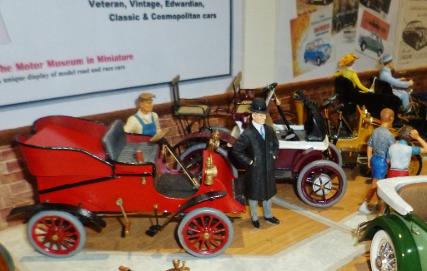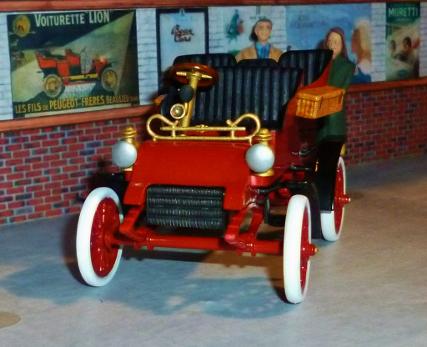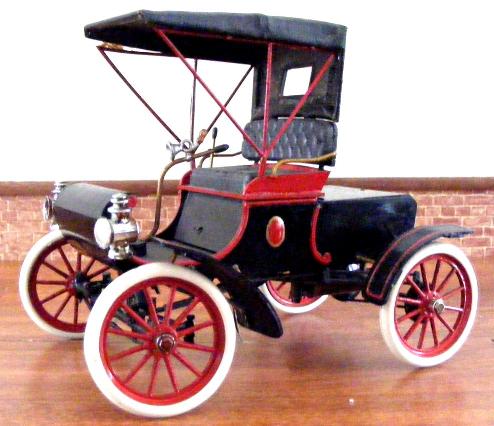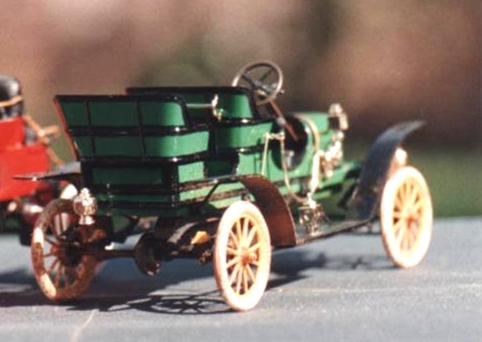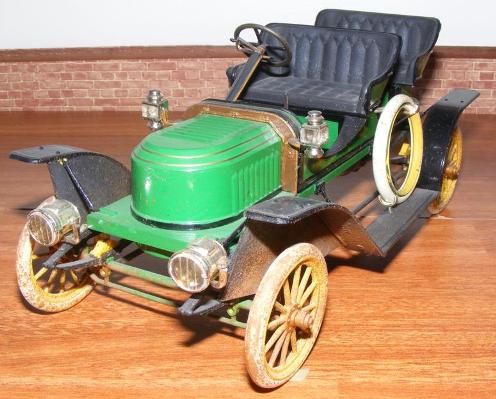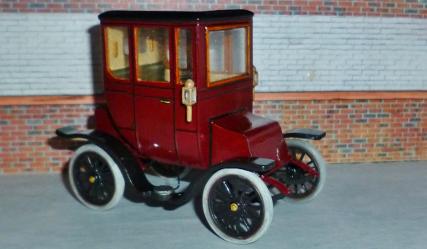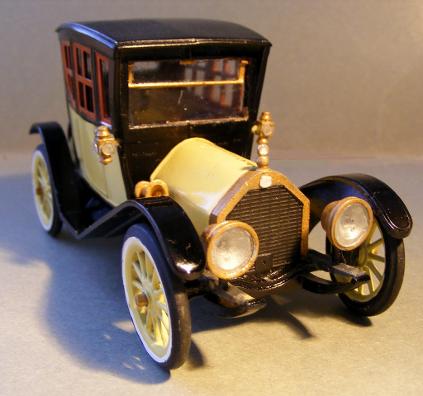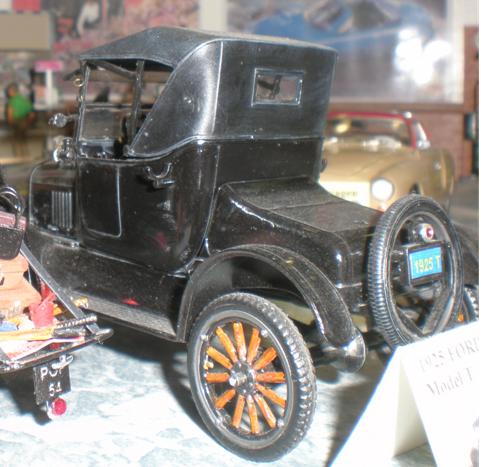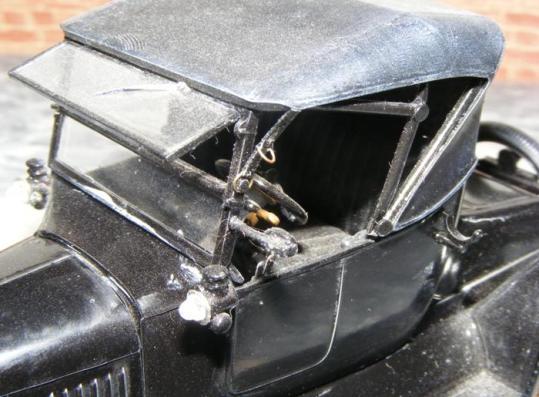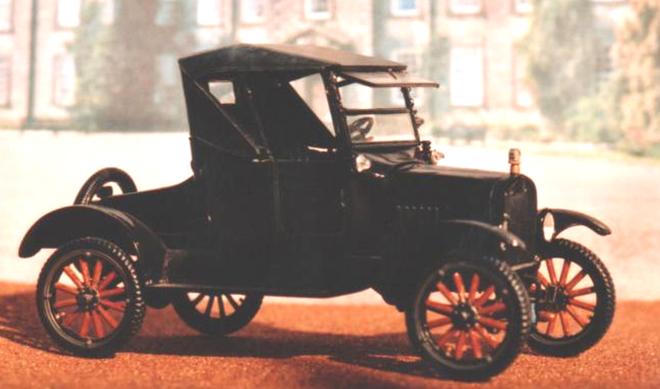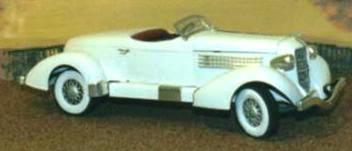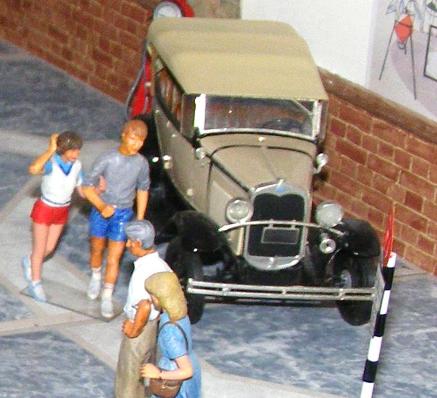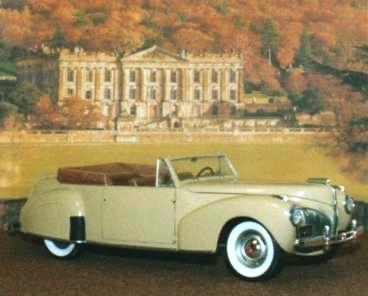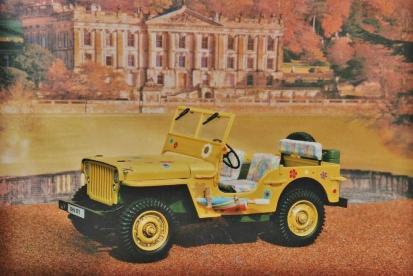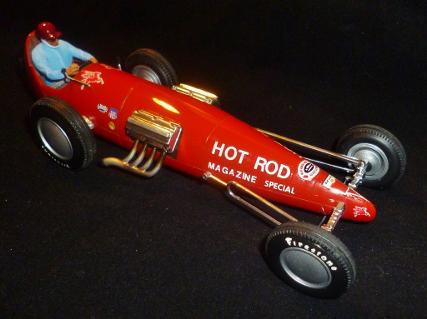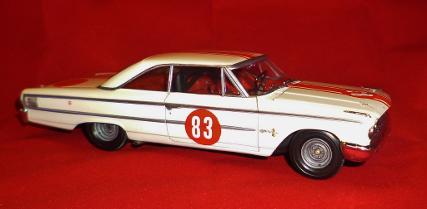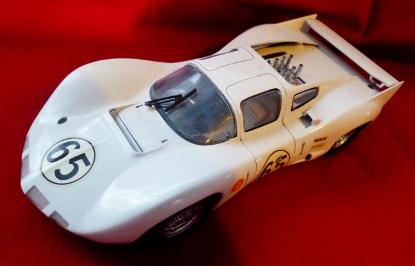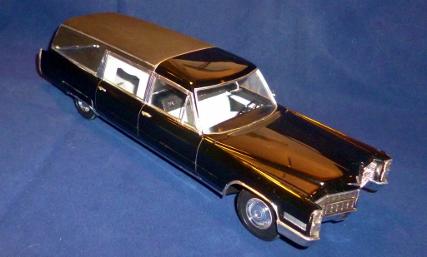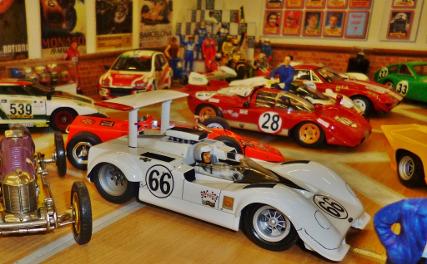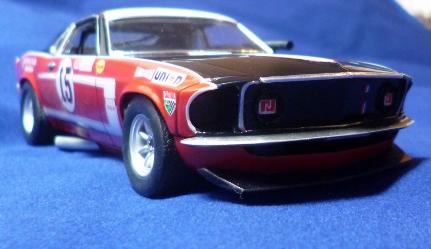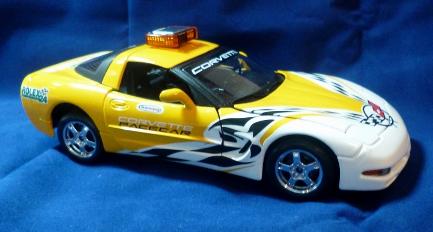The American collection.
The U.S.A. has a played a major role in developing the car. Whether by techniques for mass production, enhanced engine designs or unusual body styling, they know how to make classics in America.
1/24th scale scratch built model.
1900 Packard model 'B'
Legend has it James Packard was disappointed with his new Winton car and went to Alexander Winton with a list of suggestions for improving the car. In a conversation (argument) repeated later between Lamborghini and Ferrari, Winton told Packard if he could do better then, “build a better car”. Packard, like Lamborghini, did so; and to great effect. The Packard Motor Car Company would go on to manufacture elegant, reliable, high-quality automobiles with exceptional attention to detail and innovative features. They were so good that the firm’s sales slogan for years was simply: "Ask the man who owns one".
James Ward Packard and his brother William Dowd Packard set to work to design and built a single cylinder prototype car; the first of which was finished on the 6th of November, 1899. The first Packard Model ‘B’ was completed in the spring of 1900 and by the end of the year 49 cars of this type had been built.
1/32nd scale Highway pioneers kit released by Dapol.
1901 Olds Model R "Curved Dash".
The ‘Curved Dash’ Oldsmobile was the first mass produced car. Ransome E. Olds had been experimenting with Electric and steam cars since 1887. By 1897 he owned his father's factory and had built a good gas-engined car with which he entered the automobile business.
1/24th scale scratch built model.
1902 Rambler 8hp.
The Rambler story starts with Thomas B. Jeffery, a cycle manufacturer in Chicago, producing bicycles from 1878 to 1900. A plant in Kenosha, Wisconsin was established to manufacture his single cylinder Runabout. The first cars offered for sale in 1902 are significant as the second ‘mass produced’ cars to go into production. This was a year after the Olds Curved Dash and a year before Henry Ford started production. Production figures placed it third in the league table with 1500 cars built in 1902.
1/24th scale Hawk kit.
The first production model from the new Ford Motor Co. was, predictably, the Model ‘A’. If it bears a striking resemblance to the first Cadillac model it is because, to all intents and purposes, it is the same car, but with a different engine.
1903 Rambler Model E Runabout.
Selling for $750 dollars in 1903 the model E was finished in ‘Automobile Red’ with black fenders and fine black lining. The bonnet was used to store tools and a repair kit supplied with the car. The rear seat was a popular add-on item of the day.
1/16th scale Aurora kit.
1904 Olds Curved Dash.
The ‘Curved Dash’ Oldsmobile was the first mass produced car. Ransome E. Olds had been experimenting with steam cars since 1887. Why he had built a steam car in his fathers gas engine works we shall never know. By 1897 he owned his fathers factory and had built a good gas-engined car with which he entered the automobile business.
1/16 scale Aurora kit.
1909 Stanley Steamer.
The Stanley twins had no experience in cars before building one.
In November 1898, having built three cars, they entered one in the Horseless Carriage Meet at Boston, and, watched by five thousand cheering spectators, it averaged 27.4 mph - fast for 1898. One hundred customers put down deposits for cars. Suddenly the twins were in business.
They bought a defunct bicycle factory and began turning out cars by the thousand.
1/16 scale Aurora kit.
1910 Studebaker Electric Coupe.
In the early days of motoring the internal combustion engine had strong competition from steam and electric vehicles. Studebakers long history of building wagons and coaches proved a useful way into the emerging motor car industry, but it wasn't smooth sailing.
Despite joining forces with some other automotive companies it wasn't until Studebaker decided they could do the whole vehicle themselves that they really started to eat into the market. A firm that always had a reputation for quality it is no surprise Studebaker electric cars did sell.
But by 1910 the writing was on the wall for steam and electric powered vehicles and fortunately Studebaker moved with the times. But their contribution to the EV history should not be ignored.
1/32nd scale Dapol-Highway Pioneers kit.
1914 Regal Type N "Colonial coupe"
In 1907 Regal made 50 20hp 4-cyl. Cars and in the following year they recalled them all and gave the owners a new 1908 model free. This generosity was not repeated in following years and they settled down to make a range of conventional cars.
The car that was to make them famous was the underslung Type N design of 1910. In 1912 they introduced a coupe version, the Colonial coupe, patterned after the classic horse-drawn coaches of the early American Colonial period. It is a two seater body on the 20hp underslung 108 inch chassis.
1/32nd Revell 'Authentic scale' kit, with added details.
1925 Ford model T.
A significant landmark in motoring history occurred on the 1st October 1908, the day Ford launched the Model T. For the sake of economy all other models were dropped. Gradually as the gamble paid off and the demand grew, the methods necessary for mass-production were applied to the new car. Fords contribution to the mass production of cars was his instigation of the time & labour saving, moving assembly line. Prior to this parts had to be laboriously carried to the stationary car being built, a time consuming endeavour.
1/24th scale AMT ‘Laural and Hardy’ kit converted & detailed.
1913 Mercer 35J ‘Raceabout’.
Designed and built for racing it soon collected trophies, honours and a reputation.
The Raceabout came from the showroom ready to race, but enthusiasts found ways to make it cover a mile in much less than 51 seconds.
1/32nd scale Revell kit.
1914 Stutz Bearcat
Mention the name Stutz and someone is sure to say ‘Bearcat’. That’s the name that has been remembered. The many other models of Stutz - The Bulldog, Black Hawk and various touring and racing machines - have been long forgotten.
The first Bearcat appeared in 1912, was based on a Stutz car that had finished 11th in the 1911 Indianapolis ‘500’. The ‘Bearcat’ looked like other sporting machines of its day. A 6.2 lt. four cylinder T-head engine that developed about 60 hp. What was different was having a 3-speed transmission integral with the back axle, a favourite feature of Harry Stutz.
1/24 scale Airfix kit.
1935 Auburn 851 Speedster.
Though they were much too big and had oversize bodies, Speedsters certainly looked like sports cars. But anyone who dared to drive one as if it was a real sports car had to be very brave indeed.
A Lycoming flat head straight-8 engine of 4.5 litres, used with a centrifugal blower hp was increased from 115 hp to 150 hp. A 3-speed gearbox with a dual ratio rear axle was fitted. Each Auburn Speedster’s instrument panel carried a plate stating the speed attained on test, it was always over 100 mph.
1/25 scale Pyro kit.
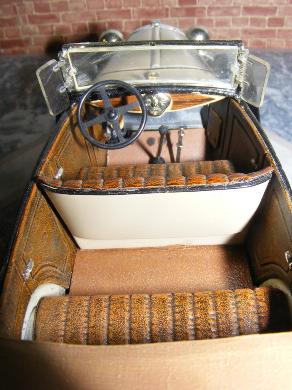
1930 Ford A Phaeton. 1/24 scale Monogram kit.
This was the much awaited, entirely new car, to replace the model T. It appeared on 2nd. December, 1927. If people expected the A to be revolutionary, they were disappointed. But the A was simple and sensible and prices started at $385. Henry was loath to give up his beloved transverse springs, and the A still sat up high on its chassis to give it a 9 ½ inch ground clearance. Rural buyers were still on Henry Fords mind. The Ford A was a good looking little machine. People called it the ‘Baby Lincoln’ and, in fact, it did have a family resemblance to its bigger relative. Some 4,500,000 A’s were sold.
1930 Ford Model AA truck.
The car, unveiled on the 20th of October 1927, was the “Model A“, named in honour of the first car Ford had produced. The new truck continued the previous double letter system as the “Model AA”. The vehicles went on sale from the 2nd of December, 1927.
An eager populace waited to see what Ford's replacement for the venerable “Model T” would be like. What they saw was not a disappointment.
The “Model A” was a completely new car.
More sophisticated, stylish and elegant. A more congenial driving position with more features which, despite being more complex, was, in comparison to its predecessor, an easier car to drive.
The AA truck model would go on to brake sales records for Ford commercial vehicles.
1940 Ford V8 Turtleback.
The famous ‘Turtle Back’ design made its debut in 1939. The more streamlined look appealed to American car enthusiasts and in its day it was considered fast, lightweight and equipped with precision steering. It had a sound reputation for dependability.
The Deluxe came equipped with front and rear bumpers with bumper guards, twin air electric horns, two tail lamps, foot-controlled headlight beams, single control tandem-action windshield wipers, a finger-tip gear shift mounted on the steering column, illuminated instrument panel, a cigar lighter, ash trays front and rear, arm rests, foot rests, swivel- type sun visors and a glove compartment complete with lock and clock! The public had a choice of six body colours and the choice of striped mohair or broadcloth in a ‘pleasing new sand shade’.
1/24th scale AMT kit.
1941 Plymouth Coupe.
The origins of the Plymouth name go back to 1928 when Joseph Frazer, Chryslers Sales Manager, suggested Plymouth as the name for Chrysler’s low-price car range to Walter Chrysler. The name referred to the historical Plymouth Rock where the Pilgrim Fathers first set foot on American soil.
Right from the start the Plymouth car range was a success, being sold alongside the more expensive models through Chrysler dealers, and by 1930 Plymouth cars were also available from Dodge and DeSoto agents.
Although Plymouth cars were more expensive than rival Ford and Chevrolet models, Plymouth offered more for the money, for example, an all steel body and hydraulic brakes.
By 1933 Plymouths market share had increased considerably, particularly after the introduction of a six-cylinder engine in 1933. By 1940, the year Walter Chrysler died, annual production of Plymouth cars had reached 500,000 units.
The 1941 Plymouth Coupe is an excellent example of the Chrysler Corporation’s emphasis on low-price luxury, with its superior ride and smooth running six-cylinder engine.
1/25th scale AMT kit.
Lincoln never set up to produce cars in large quantities. The company went into receivership in 1922 and was purchased by Henry Ford for $8million.
At that time Lincoln production totaled less than 3,500 cars. Production resumed straight after the purchase and the Lincoln division was turned over to Edsel Ford.
Termed Continental because of its rear wheel spats and rear mounted covered spare wheel in the then style of Continental cars. It was chosen by the Museum of Modern Art for excellence as a work of art only three years after it was discontinued
1942 Type 21A Deluxe
1/72nd Scale ACE kit.
The 1942 model range saw Ford redesign the Super Deluxe range. The new series of convertibles, sedans, coupes and station wagons, know as the type 21 deluxe range and released from September 1941, sported bright work around the windows, new wings (fenders), grille with re-positioned rear lights. It was a most handsome car.
World war two put a damper on car sales and by February 1942 civilian car production had ceased. Ford did find a market for their new cars amongst the armed forces of several countries, most notably of course Britain and the U.S.A.
In 1940 the United States Department of War saw the need for a light, versatile, manoeuvrable, go anywhere, reconnaissance vehicle.They came up with a very stringent set of requirements for which firms were invited to put forward their proposals. The invitations were put out on the 11th of July, 1940, with the designs to be submitted by the 22nd of July; just 11 days to digest the requirements and design a new light off road vehicle.
By the end of 1940 the US Army was clamouring for the new vehicle and the events of the 7th of December, 1941, proved they were right in all aspects and production of the Jeep went into full swing. In total around 643,000 Jeeps were produced, 363,000 by Willys and 280,000 by Ford and Bantam. The wartime Willys MB and Ford GPW (General Purpose Willys) were used for a variety of roles including fire engines, field ambulances, cable layers and artillery tractors. They saw service in all theatres of war and in the Korean and Vietnam was too.
In the civilian world the many lost and unwanted Jeeps found their way onto the roads of Asia most recognisable are the Filipino Jeepneys, stripped down and modified to carry as many passengers as possible and highly decorated to attract customers the Jeepneys also showed the promise of the Jeep design for things besides Military activities.
1942 Willys MB Jeep, 1/72nd scale Airfix kit
1948 Ford ‘Woody’.
This car marked the end of an era! The distinctive ‘fat’ fenders of the 1948 Ford disappeared into the slab sided ‘shoe box’ shape of the 1949 car, never to be seen again.
The solid I-beam front axle and transverse leaf spring, just like the old model T, would also disappear, replaced by independent front suspension. And it was the last year for Fords traditional 4-door woody wagon body, to be replaced by a 2-door partially wood bodied style for 1949.
An Estate car, Shooting Brake, or Ranch Wagon, in the USA this body style is known as a ‘WOODY’.
1/24th scale Revell-Monogram kit.
1956 Chevrolet Nomad .
Every once in a while you get a car in which, for no noticeable reason, everything goes absolutely right all the way down the line, The Chevy ‘Belle Air’ is a classic example, along with its family member the Nomad. Chevrolet styling had become slabby and dated by the early 50’s and a serious restyle was called for. Most works on classic cars concentrate on styling, on graceful kerbside elegance and long, flowing lines.
In 1955 Ed Cole produced the direct engineering equivalent of this car for all seasons. The small block V8 was an industry milestone, destined to become the most successful auto engine in history, Proving to be exactly the right product for sedans, sports cars, vans and race cars. It’s impact was so great that it is impossible to separate it from the story of the classic styling pieces from 1955-‘57.
It was the Powerglide gear box, in conjunction with this engine, with which GM first began to acquire their reputation for excellent automatic transmissions; smooth imperceptible shifts with such reliability that they were good enough to be fitted as original equipment by Rolls-Royce.
1/25th Scale Revell kit.
1957 Chevrolet Corvette .
In 1953 the mighty General Motors conglomerate responded to the British MGs, Jaguars and Austin Healeys by producing its own sports car. In creating the Corvette roadster, it established a motoring legend, even if the first cars did leave something to be desired.
As introduced in 1953, the Corvette, looked like no other GM product. As this was a low production model, it was decided to use glass fibre - then a relatively untried material - for the body. In its inaugural year of 1953, just 300 examples were built. In 1954, on a new assembly line at St. Louis, output rose to 3,640 cars but this was just a drop in the Ocean by GM standards. They considered dropping the model but decided to persevere.
For 1955 there was an egg crate-type grill concealing the new OHV V8 engine, top speed was now approaching 120mph and 60mph came up in less than nine seconds. In 1956 the Corvette got a new body on which the distinctive concave side panels were evident. Output did not exceed 10,000 units until 1960 but from there on, the Corvettes future was assured.
1/24 scale Monogram kit.
1958 Ford Thunderbird.
A clear indication that Ford market research had identified the requirements of the US market more closely than GM was the specification of the Thunderbird, they outsold the Corvette from day one, on a specification that was far higher and was just what the sporty motorist wanted.
It all changed in 1958 when information gleaned by the market researchers brought about a major change transforming the two-seat sports car into a four-seat luxury device which Ford called their ‘personal car’. It set a the tone for the next three years.
1/24th scale Monogram kit.
1963 Ford Galaxie 500 'R'code BSCC
The 1963 Galaxie was a continuation of the Ford Galaxie line, essentially the same as the '62 car but for the bodywork updates which kept the car current in looks and further keep Ford to forefront of the buying publics mind.
Ford commissioned approximately 210 ‘Lightweight’ ‘R-Code’ 427 Galaxy 500s from Holman & Moody, of Charlotte, North Carolina, USA, for Nascar racing and dully won the 1963 NASCAR championship.
However, three cars went to race in the British Saloon Car Championship. The Galaxie 500 R was a huge car by British standards, and not just in engine capacity. These cars were 30in’ longer and 13in’ wider than 3.8 Mk II Jaguar, and that wasn’t a small car either. The greater horse power would take 'Gentleman' Jack Sears to the BSCC championship the same year.
1/25th scale AMT kit
1965 Ford Mustang.
Until the 1960’s, the Grand Tourer could be defined as a fast, low production, expensive car with closed bodywork. All this changed in 1964 when Ford in America introduced its Mustang which was destined to become one of the fastest selling cars in the history of the US motor industry. An amazing 1.7 million examples were produced within in 4 years. In Britain it spawned the Ford Capri which moved the concept into the European market.
Ford, which had hitherto lacked a sporting profile, adopted what it called a “total performance” image. The Mustang was the car to break new ground.
1/24th scale kit Monogram kit.
1963 Studebaker Avanti.
The Avanti coupe, a glass fibre bodied American sports car with a distinctly European appearance, was produced in the final years of the company. Although it made little impact on the firm’s tottering finances, so advanced were its specifications that the car does not look out of place to-day.
The most striking feature of the glass-fibre body was the apparent absence of a radiator grille.
The interior was similarly distinctive and possessed an aviation flavour: the white on black instruments bathed in a soft red light for night driving and controls placed, aircraft style, in the roof.
1/25th scale kit AMT kit.
1966 Chaparral 2D
1/24th scale Monogram kit.
Jim Hall and Hap Sharp formed Chaparral Cars in 1962 and drove/managed their cars through until 1970. The company was named after the roadrunner, a fast-running ground cuckoo (hero for a generation of cartoon lovers) that is actually called a Chaparral.
The 2D was the first closed cockpit Chaparral the earlier cars all being the open cockpit cars. It was designed for endurance racing and competed in the 1966 Le Mans and won Nürburgring 1000 km in the hands of Phil Hill and Joakim Bonnier.
1969 Ford Mustang Boss 302 'Trans-Am'
1/32nd scale Hornby kit.
Ford's Mustang reached it's 50 year anniversary in 2014 and many people are looking back over the range that has not only been a popular car on the roads but also a star of the screen and the track.
One of the track stars was the Boss 302, introduced in 1969. It won the first round of the Trans-Am series that year but ultimately fell short of the goal that year. In 1970 Parnelli Jones took the Bud Moore engineering team to the Trans-Am title and the Boss 302 took its place in history.
2000 Chevrolet Corvette C5 pacecar.
1/24th scale Bburago kit
Chevrolet's 5th incarnation of the Corvette used the pinnacle of design and materials making it a truly cutting edge production car. Understandably it was in demand for official duties at race circuits and not long after put on new clothes and went racing itself in the for of the C5r which won it's class at le Mans two years running.
We hope you have enjoyed this look at some of the historic classics from the United States of America. Of course there are many more cars that could be here and I'm sure more will be added in the future. But if you crave a little more American automotive history then visit our Ford Collection.
